Creating the perfect climate is easy! Country house heating options
You are viewing the section Country house, located in the large section Heating.
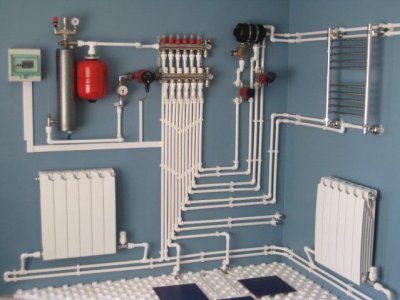
Recently, more and more people have become disillusioned with central heating.
The equipment is not working efficiently: There are large heat losses, which increases utility bills. People switch to autonomous heating.
The peculiarities of organizing heating in a country house are that various factors need to be taken into account, for example, the layout and area of the premises. Today, such types of heating for country houses as stoves, fireplaces, boilers, convectors, heaters are popular.
Gas heating system for a country house
Gas heating - the most popular option for country houses in Russia. It is characterized by ease of use and low price. Almost every settlement can be connected to the central gas pipeline. In its absence, the use of gas cylinders will be expensive.
The main part of the heating system is gas boiler. It heats the coolant, and from there the heat is distributed through the pipes, heating the house.
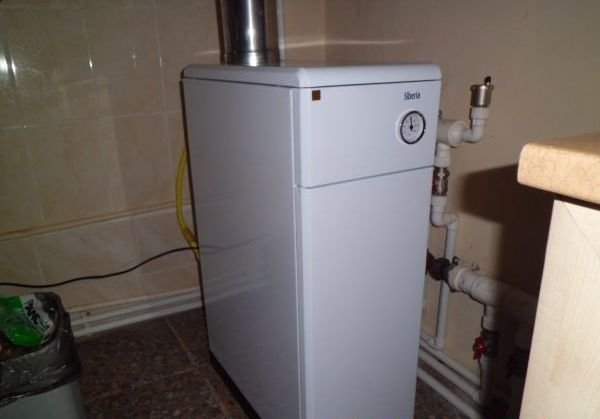
Photo 1. Gas boiler for heating a private house. The device is connected to the water circuit.
The system consists of the following parts:
- from the burner (automatic in modern boilers);
- from fittings that supply and regulate gas;
- from a heat exchanger (usually copper, cast iron or steel);
- from the safety valve;
- from the circulation pump;
- from the expansion tank;
- from the electronic control system.
When turned on automatically The room temperature is measured to determine the amount of heat required. Then the armature is activated: the required amount of gas is supplied to the system. At this point, a spark is ignited in the combustion chamber, and the gas ignites. In the heat exchanger, the water (heat carrier) is heated to the required temperature and, using a pump, is supplied through pipes to the radiators, which ensures heating of the house.
Reference. This is how a gas boiler works. with one circuit. Dual-circuit device installed if there is a need to heat water for hot water supply.
Advantages of gas heating:
- Gas is the most accessible and inexpensive fuel.
- A protection system is installed that responds with a signal if the gas supply stops. You must shut off the gas yourself.
- Self-diagnostic unit that displays errors on the display in the form of codes.
Cons:
If it is necessary to heat two circuits simultaneously, the operation of one of them will be weak or will be suspended. In practice, this does not cause any inconvenience.
Electric heating options
One of the simplest ways to heat, but considering the cost of electricity, quite expensive. There are several options for heating with electricity.
Electric boilers
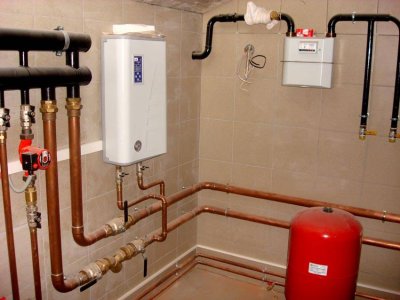
Distinguish 3 types of modern boilers — Heating elements, induction, electrode.
Operating principle:
- In a heating element device the main element is the heating element, which heats up under the influence of current. The water in it is heated and transferred to the radiators.
- In the induction unit there is an electromagnetic field emitter and a metal receiver that is affected by this field. The receiver is a pipeline in which water (heat carrier) circulates and is transferred to the heating system.
- Electrode boiler — a relatively new modern device. Its difference is that it does not have a heating element. The peculiarity is a converter that affects free water ions. An alternating electronic field affects ions, forcing them to move, collide with other particles. As a result, heat is released and the water is heated.
Advantages of heating with electricity:
- The electric boiler is the least expensive of all types.
- Installation in a house is permitted without the consent of any organizations (they do not exist).
- High efficiency - almost 100%.
- Silent operation of devices.
- Heating element and induction boilers are equipped with protection against power failure in the event of a coolant leak.
- In the electrode unit, coolant leakage is impossible. The boiler will not turn on without water in the chamber. Lime does not settle in it.
Cons:
- High cost of electricity.
- In a heating element boiler, during operation, if the water is hard, lime deposits may form, which affects heat exchange.
- Induction units also experience limescale build-up, but it takes a long time before this affects the performance of the unit.
- Over time, the electrodes, interacting with ions, are destroyed. They need to be replaced.
Warm floor
It is a structure consisting of a heating cable and a thermostat, which operates using electricity and is installed under the floor covering. Warm floors are represented by cables and cable mats.
Operating principle:
- Heating cable. If necessary, heat-insulating material is laid on the concrete surface. A heating cable with a temperature sensor is installed on top of it (if a thermostat with a built-in sensor is not used). Then a concrete screed with a thickness of from 2 cm, and any floor covering is placed on top.
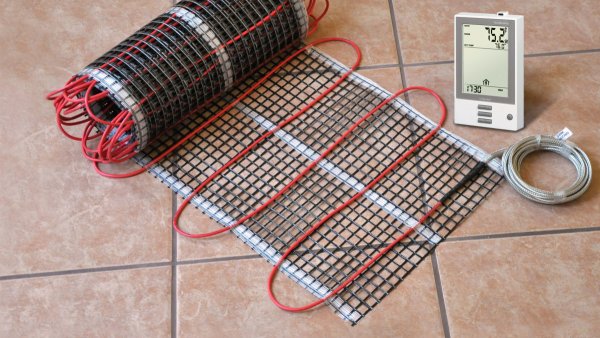
Photo 2. Warm floor, presented in the form of a heating cable. Has an electronic control system that allows you to regulate the heating temperature.
- Heating mat. It is used as a heating element under laminate. It cannot be laid under linoleum. The heat is emitted by the heating cable and transferred to the floors.
- Self-regulating cable. It works without a thermostat. Its operating principle is based on a matrix that automatically selects and regulates the optimal temperature. This cable is suitable as heating under linoleum.
Advantages of heating:
- Suitable for any floor covering;
- presence of a thermostat;
- uniform heating of the entire surface area;
- no additional equipment installation required.
Cons:
- High operating costs.
- Additional costs for RCD and grounding.
- Wooden flooring can dry out and become deformed when heated.
- When laying the floor, the height of the walls is reduced up to 10 cm.
Infrared heating
The source is infrared emitters. Heat transfer occurs directly to people and objects, without heating the air.
IR film consists of a heating element, protective film, reflector (foil). The heating system is built by the type of natural heat exchange.
Operating principle:
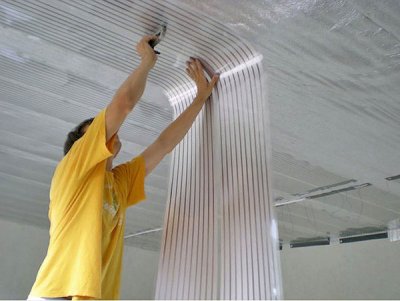
The film is usually attached to the ceiling. Current passes through the carbon-coated foil, heating it up to 45 degreesThe foil serves as a reflector.
In its characteristics, infrared radiation is similar to the thermal radiation emitted by the sun.
The film is also used as a floor under any floor covering.
Advantages of heating:
- easy installation;
- can be installed on any ceiling surface or under any floor covering;
- high efficiency;
- large heating area;
- durability and reliability;
- does not dry the air in the room, does not burn oxygen.
Cons:
- High power requirement.
- The room must be well insulated to avoid heat loss.
IR heater
This is a device that gives off heat into the air space using IR radiation. Allows you to heat a certain area in the room. The effect occurs immediately after switching on. Depending on the type of installation, the units are stationary or portable. They differ in the range of wave emission and the type of power source (gas and electric).
Operating principle:
The main element of the electric IR heater is emitter (heating element, lamp or spiral). As in the case of IR films, electrical energy is converted into thermal radiation by means of an emitter, which does not heat the air, but reaches the surfaces of objects and people in its area of action. They, heating up, give off heat into space.
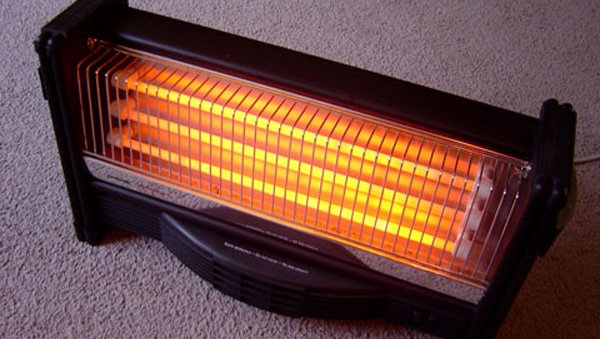
Photo 3. Infrared (IR) heater. The device operates on electricity, heats the air using a special coil.
Advantages of heating:
- High efficiency.
- Light weight, mobile.
- Quick provision of heat to a specific area of the room.
- Energy consumption is lower than with other methods of heating with electricity.
- There are no air flows as with convector heating.
- Silent operation.
- They do not burn oxygen and do not dry the air.
Cons:
- High cost.
- A large room takes a long time to warm up.
- The heater must not be placed near other appliances or furniture to avoid damage due to temperature.
- Deterioration of health due to prolonged exposure to infrared radiation.
Heaters, electric fireplaces, convectors
Oil heater — the most popular and easy-to-use heater. Externally looks like a battery. The device consists of a heating element and a housing with mineral oil. The unit is equipped with an overheating protection system, a tip-over sensor. It switches off when dropped or overheated.
Operating principle:
After turning on the heating element heats the oil within half an hour. The oil boils - the heat is gradually transferred to the body, which releases it into the air. Warm heated air is distributed throughout the room by convection. The speed and time of heating the room depend on the power and design of the device.
Attention! If the oil heater fails, it may explode. This happens due to overheating and boiling of the coolant, as a result of which the heater seam comes apart and hot oil splashes out.
Advantages of heating:
- High safety: the housing heats up no higher than 60 degrees.
- Durability and reliability.
- Working time without breaks up to 3 days.
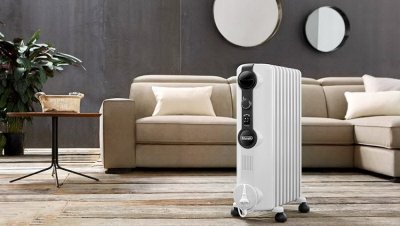
- Silent operation.
- Price.
Cons:
- heats the room for a long time;
- large mass of the device;
- dries the air.
Electric fireplace - an electrical device that imitates traditional fireplace with heating function. The unit consists of a hearth (firebox) and a portal (frame). In the center of the hearth there are "firewood" with strips of fabric, an incandescent lamp and a fan.
Operating principle:
The lamp, heating up, illuminates the wood, the fan drives the air, and the material moves like tongues of flame. The heating function is carried out thanks to the built-in spirals. To regulate the degree of heating, a control unit is built into the fireplace. When the room temperature becomes optimal, the thermostat automatically switches off the heating. When the temperature drops, it starts producing heat again.
Advantages of heating:
- silent operation of the device;
- high efficiency;
- low energy consumption.
Cons:
During operation it burns a lot of oxygen, so the room must have good ventilation.
Convector — the device looks like a battery with holes.
Operating principle:
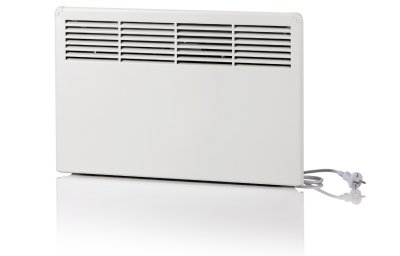
Air enters through the side openings and, after heating up, exits through the front ones.
The heating element consists of a special alloy that heats up quickly. A minute after switching on, the convector gives off heat to the room.
Advantages of heating:
- Due to the low temperature of the convector, oxygen in the air is not burned.
- The heating element is large, so it produces enough heat.
- Convectors are considered the safest.
- Compact size units.
Cons:
- high power consumption;
- It won't heat a large room.
Heating a country house without gas
There are still some parts of Russia that do not have gas heating, and electric heating is too expensive for most Russians. People still heat their homes the old-fashioned way, using firewood. The younger generation is increasingly using solar panels.
Furnaces
It is a traditional method of heating and is not inferior to modern heating methods. Stoves can be made of stone or brick.
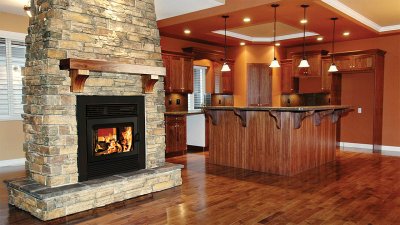
Operating principle:
The firewood is lit in the firebox. When burning, it produces heat - the stove and the surrounding space heat up.
After some time, the temperature in the room drops, then you need to add a new batch of firewood.
Advantages of heating:
- energy independence and autonomy;
- retains and releases heat for a long time;
- multifunctionality (heating, water heating, cooking);
- easy to repair;
- low-cost and affordable method.
Cons:
- Long warm-up.
- Uneven distribution of heat in the rooms.
- Risk of carbon monoxide poisoning if safety precautions are not followed.
- In winter, the stove needs to be heated every day.
- Rapid heating contributes to the formation of cracks in the oven.
Solar heating
An alternative to all traditional heating methods. Heating your home with solar energy is done by means of solar panels and collectors.
The solar battery consists of 3 parts:
- from a panel (glass, plastic), inside which the coolant circulates;
- from a metal surface that absorbs solar energy;
- from the storage tank.
Operating principle:
Solar panels used to generate electricity from solar radiation. Light affects semiconductors, they form a direct current. Voltage appears and is supplied to objects. A special battery accumulates electrical energy.
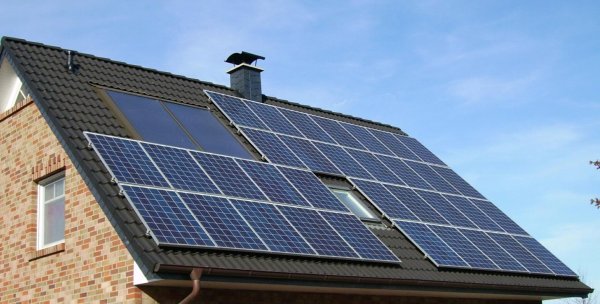
Photo 4. Solar collectors installed on the roof. The devices convert solar energy into heat.
Solar collectors — devices that convert solar energy into heat. Mounted on the roof of the house.
Operating principle:
The all-season collector works on the principle of a thermos. It consists of pipes that are located one inside the other and fastened in parallel. There is a vacuum between the pipes inside, which serves as thermal insulation. The inner tube is covered with heliotan - this substance retains solar energy. The collector works even at low temperatures in any weather. The coating of the inner pipe helps to warm up the coolant up to 48 degrees. The heated coolant (antifreeze, water) is transferred to the heat exchanger.
There are flat solar collectors, consisting of plates that absorb heat using heliotan. The latter are placed in glass-ceramic panels, and the bottom is protected by thermal insulation.
Advantages of heating:
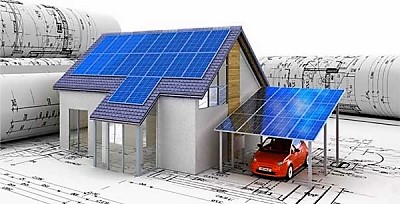
- accumulate energy and heat in any weather;
- fuel savings;
- easy to use;
- long service life;
- year-round hot water supply and electricity.
Cons:
- Expensive equipment and installation.
- In cloudy weather, less energy and heat is generated.
Useful video
Watch the video, which tells about the most efficient and economical way to heat a country house.
Selection of equipment
Exists there are many options heating of a country house. The choice depends on many factors, including the financial capabilities of the owners. The main advantage of autonomous heating systems is economy. The heating system must be reliable, compact, and durable. If the equipment is made conscientiously and installed correctly, it will work without interruption. The cost of quality equipment is the key to savings in the future.






